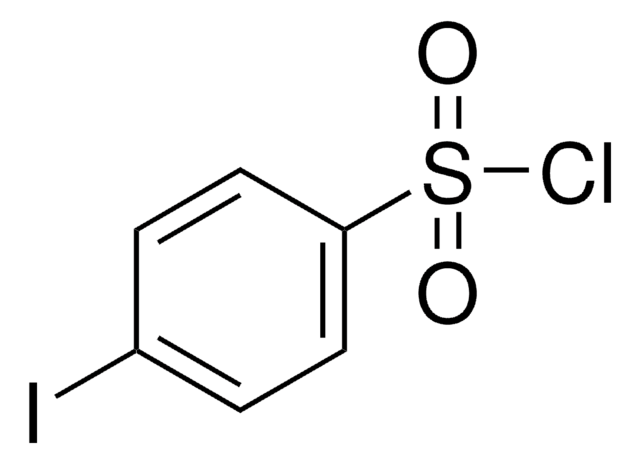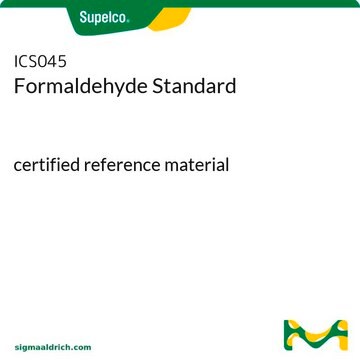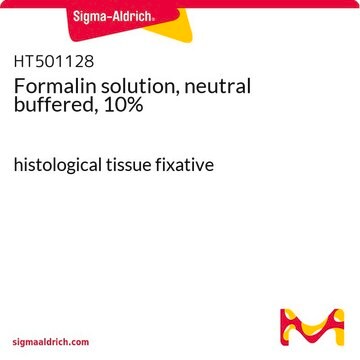Products may be shipped at a different temperature than the recommended long-term storage temperature. If the product quality is sensitive to short-term exposure to conditions other than the recommended long-term storage, it will be shipped on wet or dry-ice. If the product quality is NOT affected by short-term exposure to conditions other than the recommended long-term storage, it will be shipped at ambient temperature. As shipping routes are configured for minimum transit times, shipping at ambient temperature helps control shipping costs for our customers. For more information, please refer to the Storage and Transport Conditions document: https://www.sigmaaldrich.com/deepweb/assets/sigmaaldrich/marketing/global/documents/316/622/storage-transport-conditions-mk.pdf
252549
Formaldéhyde solution
ACS reagent, 37 wt. % in H2O, contains 10-15% Methanol as stabilizer (to prevent polymerization)
Synonyme(s) :
Formol
About This Item
Produits recommandés
Qualité
ACS reagent
Niveau de qualité
Densité de vapeur
1.03 (vs air)
Pression de vapeur
52 mmHg ( 37 °C)
52 mmHg ( 37 °C)
Forme
liquid
Température d'inflammation spontanée
572 °F
Contient
10-15% Methanol as stabilizer (to prevent polymerization)
Concentration
36.5-38.0%
37 wt. % in H2O
Impuretés
≤0.006 meq/g Titr. acid
Résidus de calcination
≤0.005%
Couleur
APHA: ≤10
Indice de réfraction
n20/D 1.3765
Solubilité
water: soluble
Densité
1.09 g/mL at 25 °C (lit.)
Traces d'anions
chloride (Cl-): ≤5 ppm
sulfate (SO42-): ≤0.002%
Traces de cations
Fe: ≤5 ppm
heavy metals: ≤5 ppm (by ICP-OES)
Adéquation
suitable for manufacturing use (Laboratory chemicals)
Chaîne SMILES
[H]C([H])=O
InChI
1S/CH2O/c1-2/h1H2
Clé InChI
WSFSSNUMVMOOMR-UHFFFAOYSA-N
Vous recherchez des produits similaires ? Visite Guide de comparaison des produits
Description générale
Application
Forme physique
Souvent commandé avec ce produit
Mention d'avertissement
Danger
Mentions de danger
Classification des risques
Acute Tox. 2 Inhalation - Acute Tox. 3 Dermal - Acute Tox. 3 Oral - Carc. 1B - Eye Dam. 1 - Flam. Liq. 3 - Muta. 2 - Skin Corr. 1B - Skin Sens. 1 - STOT SE 1 - STOT SE 3
Organes cibles
Eyes,Central nervous system, Respiratory system
Code de la classe de stockage
3 - Flammable liquids
Classe de danger pour l'eau (WGK)
WGK 3
Point d'éclair (°F)
132.8 °F - closed cup
Point d'éclair (°C)
56 °C - closed cup
Faites votre choix parmi les versions les plus récentes :
Déjà en possession de ce produit ?
Retrouvez la documentation relative aux produits que vous avez récemment achetés dans la Bibliothèque de documents.
Les clients ont également consulté
-
How is shipping temperature determined? And how is it related to the product storage temperature?
1 answer-
Helpful?
-
-
How can I determine the shelf life / expiration / retest date of this product?
1 answer-
If this product has an expiration or retest date, it will be shown on the Certificate of Analysis (COA, CofA). If there is no retest or expiration date listed on the product's COA, we do not have suitable stability data to determine a shelf life. For these products, the only date on the COA will be the release date; a retest, expiration, or use-by-date will not be displayed.
For all products, we recommend handling per defined conditions as printed in our product literature and website product descriptions. We recommend that products should be routinely inspected by customers to ensure they perform as expected.
For products without retest or expiration dates, our standard warranty of 1 year from the date of shipment is applicable.
For more information, please refer to the Product Dating Information document: https://www.sigmaaldrich.com/deepweb/assets/sigmaaldrich/marketing/global/documents/449/386/product-dating-information-mk.pdfHelpful?
-
-
Can you store formaldehyde in plastic?
1 answer-
This product is packaged in glass bottles. Generally, formaldehyde solution can be used in plastic containers. However, it is advised that the unused material be preserved in its original packaging.
Helpful?
-
-
What type of packaging for different packages?
1 answer-
This product is packaged in amber glass bottles with polypropylene caps with HDPE liners. The bottle sizes are as follows:
252549-25 ML in 50 ml bottles
252549-100 ML in 100 ml bottles
252549-500ML in 500 ml bottles
252549-1L in 1L bottles
252549- 4L in 4L bottlesHelpful?
-
-
Can formaldehyde solution 37% be diluted to 10% formalin for fixing cells for staining? Do you dilute it with around 2.7 part water? Thank you!
1 answer-
How much water should be added to 100mL of a 37% solution to reduce its strength to a 10% solution?
Use C1 x V1= C2 x V2
37% x 100ml = 10% x V2
Therefore V2 = (37% x 100ml) / 10%
= 370 mLSubtract the total original volume from the new volume.
370 mL - 100 mL = 270 mL
So to reduce 100mL of 37% to 10% solution, add 270 mL of water to 100 mL of Formaldehyde solution - 252549-25ML.Helpful?
-
-
Which formaldehyde solution is recommended for use with the HT102A Reticulum kit?
1 answer-
When a silver stain procedure recommends a 10% formalin solution, it is referring to a 10% aqueous formalin solution, which is prepared by diluting 1 part of 37% to 40% formaldehyde with 9 parts deionized water. For histology, it is advisable to use ACS reagents when the product meets ACS Specifications. Suitable products for this purpose would be product numbers 252549 or FX0410. If a 37% to 40% formaldehyde solution is available, it should work; however, it's important to avoid using old bottles of this solution that have been in the lab for several years, as impurities can form over time. Solutions used in histological procedures should typically be replaced every 2 years to ensure effectiveness.
Helpful?
-
-
Is the methanol content in the CoA expressed as volume percent or weight percent?
1 answer-
The methanol content is expressed as weight percent.
Helpful?
-
-
What is the Department of Transportation shipping information for this product?
1 answer-
Transportation information can be found in Section 14 of the product's (M)SDS.To access the shipping information for this material, use the link on the product detail page for the product.
Helpful?
-
-
Is the concentration of Product No. 252549, Formaldehyde solution, expressed as a weight percent solution?
1 answer-
Yes, 37% is a reference to weight percent solution. Unless otherwise noted, this is the standard practice for reporting concentration by percent. In terms of volume percent, this solution would be approximately 40% by volume.
Helpful?
-
-
What is the difference between formaldehyde and paraformaldehyde?
1 answer-
Paraformaldehyde is the polymeric form of formaldehyde. Paraformaldehyde is a solid, and formaldehyde is a gas. Formaldehyde solutions consist of formaldehyde gas dissolved in a solvent of some kind.
Helpful?
-
Active Filters
Notre équipe de scientifiques dispose d'une expérience dans tous les secteurs de la recherche, notamment en sciences de la vie, science des matériaux, synthèse chimique, chromatographie, analyse et dans de nombreux autres domaines..
Contacter notre Service technique












